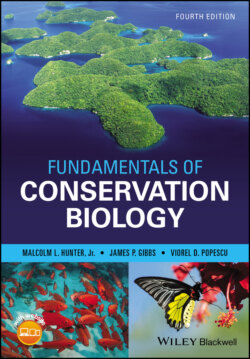Читать книгу Fundamentals of Conservation Biology - Malcolm L. Hunter Jr. - Страница 17
Preservation
ОглавлениеThe roots of preservation are probably almost as ancient as the origins of spirituality. When religious leaders began to set rules for society, some species were protected as totems and some places like certain mountains were recognized as sacred and thus decreed off‐limits or visited only on religious occasions (Fig. 1.2). Moving ahead many millennia, the establishment in 1872 of Yellowstone National Park, the world's first national park, is often identified as the beginning of governmental policy codifying the value of preservation. Here were nearly 10,000 square kilometers of evidence that society valued the landscape’s sacredness; that its aesthetic qualities (particularly striking geological features like geysers and hot springs) justified removing some natural resources from the path of economic development. The national park movement has developed throughout the world and has been modified in many ways. Some preserves are off‐limits even to visitors, such as the many zapovedniks (strictly protected areas) of Russia, while some parks, especially in Europe and India, maintain traditional cultural practices such as historic livestock grazing regimes. Nevertheless, the underlying value system remains largely intact. This same preservationist value system has also curtailed the exploitation of some species, such as various kinds of whales and songbirds, in many places. Obviously, species that are on the brink of extinction are slated for preservation, but others are simply species for which preservation has been deemed preferable to utilization. Many countries, for example, have banned the harvesting of all songbirds even though some species could be harvested in a sustainable manner.
Figure 1.2 Mount Fuji [top] has been a sacred mountain for the Buddhists and Shintoists of Japan for many centuries. (Tofoli.douglas/Flickr/Public domain) For the indigenous people of the Pacific Northwest, totem poles [bottom] often depict species that represent family identity and history, and have a sacred role in their culture.
(Bernard Spragg/Flickr/CC0)
